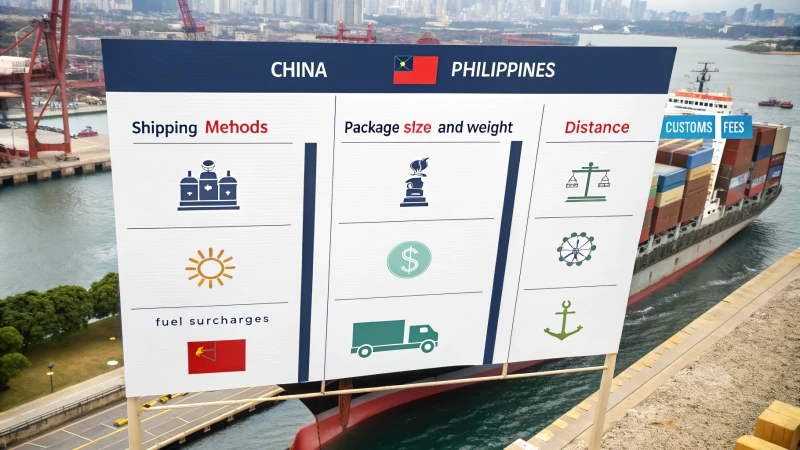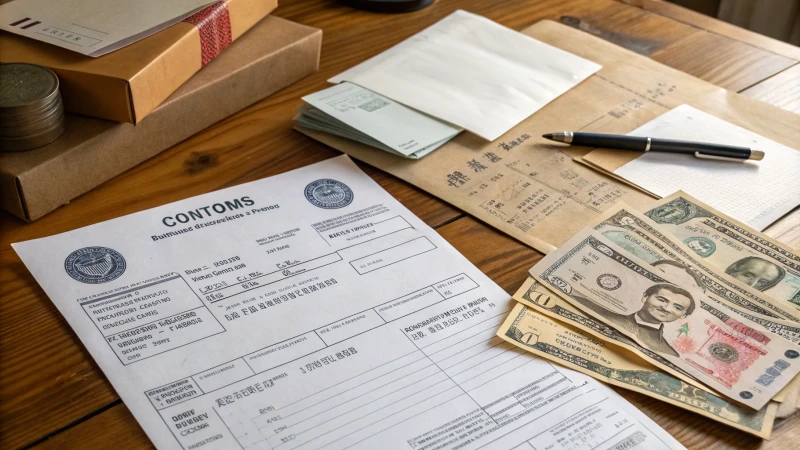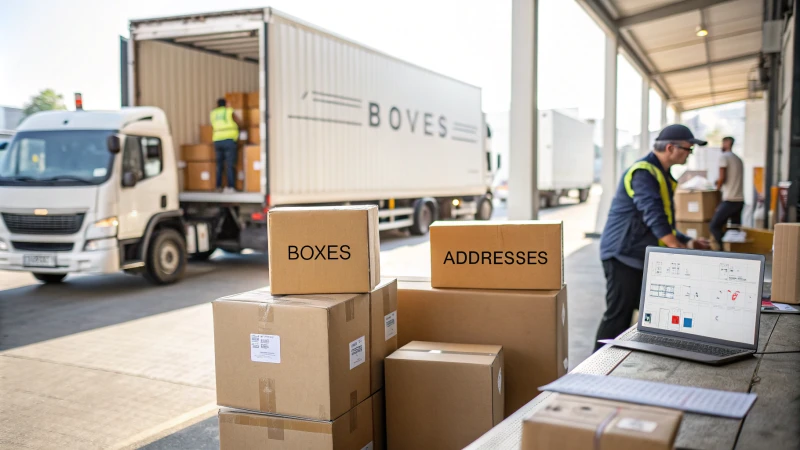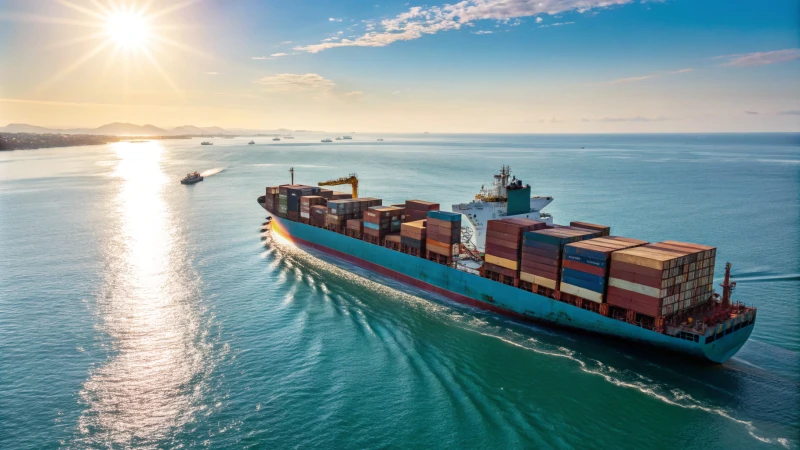Every penny counts when shipping from China to the Philippines, especially in the bustling world of import and export.
Shipping goods from China to the Philippines is most cost-effective by sea freight, with rates usually between $25 and $70 per cubic meter. This method beats air freight in terms of economy, but final costs vary based on factors like package size and delivery options.
I remember when I first started my electronics business. I was so focused on getting the best products that I overlooked how much the shipping costs could eat into my profits. I quickly learned that while sea freight might take a bit longer, it’s the most economical choice for larger shipments. Diving into the details, factors like package dimensions and weight can tweak those costs.
Now, let's take a closer look at what you need to know to make the most informed shipping decisions. Understanding these elements not only saves money but also ensures your products reach your customers smoothly.
Sea freight is the cheapest shipping from China to Philippines.True
Sea freight typically costs $25-$70 per cubic meter, cheaper than air.
Air freight costs less than sea freight for shipping to the Philippines.False
Air freight is generally more expensive than sea freight due to speed.
How Do Sea and Air Freight Costs Compare?
Have you ever found yourself torn between choosing sea or air freight for your business needs?
Sea freight usually offers a more cost-effective solution than air freight, especially when dealing with large shipments. However, air freight, despite being pricier, provides quicker delivery, making it ideal for urgent or high-value cargo.
Comparing Cost Structures
When it comes to moving goods across oceans, I've learned from my years in the import/export business that choosing between sea and air freight isn't just about numbers. It's about strategy. For instance, sea freight charges based on volume, which ranges from $25 to $70 per cubic meter from China to the Philippines. This makes it a go-to for bulk shipments.
| Shipping Method | Cost (per cubic meter) | Best For |
|---|---|---|
| Sea Freight | $25 - $70 | Bulk shipments |
| Air Freight | Higher than sea freight | Urgent or high-value shipments |
Speed vs. Cost Efficiency
There's a particular shipment of consumer electronics I remember; I was on edge because we needed those items urgently. Air freight was the savior, despite the higher costs. It brought the goods within days—a luxury I occasionally indulge in when time is of the essence. But if you can wait, sea freight stretches those dollars further by delivering within weeks.
When considering logistics efficiency1, air freight's primary advantage is speed. Businesses dealing in perishable or time-sensitive products often opt for air freight despite the premium price.
Additional Factors Affecting Costs
The nature of your cargo also plays a significant role. Have you ever faced the dilemma of shipping oversized or dangerous goods? The extra fees can add up quickly in either mode. And then there are the peak seasons—like holidays—when air freight costs skyrocket.
For folks like me at Joson’s wholesale enterprise2, weighing these factors carefully ensures we make decisions that align with our business needs.
Environmental Considerations
Nowadays, I'm also more conscious of my carbon footprint. Did you know air freight has a larger carbon footprint per unit transported compared to sea freight? Yet, some clients prefer its efficiency. Balancing speed with sustainability is something I continually grapple with, assessing environmental impact3 as part of my logistics choices.
Sea freight is cheaper than air for large shipments.True
Sea freight charges per cubic meter, making it economical for bulk.
Air freight is always more cost-effective than sea freight.False
Air freight costs more due to speed and urgency, not cost efficiency.
How Do Different Factors Impact Shipping Costs from China to the Philippines?
Shipping can be like piecing together a puzzle, and each factor is a crucial piece that affects the final picture. Understanding these factors is key to mastering cost-effective logistics.
Shipping costs from China to the Philippines depend on factors like the shipping method, package size and weight, distance, customs fees, and fuel surcharges. Choosing the right approach can significantly reduce expenses.

Shipping Method
I remember when I first started in this business, choosing between sea freight4 and air freight felt like deciding between speed and savings. Sea freight is my go-to for bulk shipments because it's generally more economical. But if time is of the essence, air freight, albeit pricier, ensures quick delivery.
Package Size and Weight
I once had a shipment of lightweight but bulky items. To my surprise, the shipping cost was higher than expected due to volumetric weight calculations. It taught me the importance of understanding how both size and weight influence charges.
| Package Type | Cost Implication |
|---|---|
| Small & Light | Lower costs |
| Large & Bulky | Higher volumetric charges |
Distance and Routes
Deciding on a shipping route is like picking a travel itinerary. Direct routes cost more but offer faster delivery, which is crucial for time-sensitive goods. I learned that balancing cost with delivery speed can make a big difference in meeting client expectations.
Customs Fees
I recall an incident when unexpected customs fees caught me off guard. Since then, I've made it a point to understand duties and taxes thoroughly to prevent such surprises.
Fuel Surcharges
Fuel prices fluctuate like a rollercoaster, impacting surcharges. Staying updated with market trends helps me anticipate changes and adjust my strategies accordingly.
For a more tailored approach, I've found consulting with a reliable logistics partner like Gofreighter invaluable. Their expertise in global logistics ensures I navigate these factors effectively, leading to smoother operations. Explore more services5 they offer to optimize your shipping strategy.
Sea freight is cheaper than air freight for bulk shipments.True
Sea freight offers lower costs for large volumes, unlike air freight.
Customs fees are the same for all product types and values.False
Customs fees vary based on the type and value of the product.
What Hidden Costs Should I Expect in International Shipping?
Navigating international shipping can feel like unraveling a mystery with unexpected costs lurking around every corner. Knowing what to expect can save both headaches and money.
Hidden costs in international shipping include import duties, taxes, customs clearance fees, and surprise surcharges. Being aware of these can help avoid financial shocks and ensure a more accurate shipping budget.

Common Hidden Charges in International Shipping
When I first dove into the world of international shipping, it felt like learning a new language. I remember how blindsided I was when unexpected fees cropped up, threatening my budget. One thing that caught me off guard was the dreaded import duties—those pesky taxes that vary depending on the type of product and its origin.
- Import Duties: They can change dramatically depending on where you're shipping to and what you're shipping.
- Customs Fees: These are charges for getting your goods through customs, and they can sneak up on you if you're not prepared.
- Unexpected Surcharges: Things like fuel surcharges can crop up due to market fluctuations.
| Charge Type | Description |
|---|---|
| Import Duties | Taxes on imports, dependent on product and origin |
| Customs Fees | Processing charges by customs authorities |
| Additional Surcharges | Unplanned costs like fuel surcharges |
Understanding Import Duties and Taxes
Import duties are just one piece of the puzzle. I discovered the hard way that goods might also be subject to Value-Added Tax (VAT) or other local taxes. It was a steep learning curve, but knowing this in advance could have painted a clearer picture of my total costs.
The Harmonized System (HS) code was another mystery to crack. This code classifies products to figure out duties and taxes. Using an HS code6 lookup tool is now my go-to trick for clarity.
Customs Clearance Fees
Then there's the matter of customs clearance fees. I found out these are charged by customs brokers to process shipments through customs. These fees fluctuate based on how complicated the shipment is or how many items are in it.
Getting advice from a freight forwarder7 helped me understand how to minimize these fees. They often include them in service packages, which can make life easier.
Handling Additional Surcharges
Fuel surcharges have also taken me by surprise. They're common due to fluctuating fuel prices and can hit during peak seasons like holidays with congestion surcharges. Staying in touch with my logistics provider8 has helped me keep these in check and plan accordingly.
| Surcharge Type | Reason for Occurrence |
|---|---|
| Fuel Surcharge | Changes in fuel prices |
| Congestion Surcharge | Seasonal demand fluctuations |
By understanding these charges, I've learned to navigate international shipping better without the stress of hidden costs catching me off guard.
Import duties are the same for all countries.False
Import duties vary by country and product type.
Customs fees are a fixed charge worldwide.False
Customs fees vary based on shipment complexity and items.
How Can I Ensure a Reliable Shipping Experience?
Ever found yourself anxiously checking if a shipment has left the dock yet? Trust me, I’ve been there.
To ensure a reliable shipping experience, I focus on picking trustworthy carriers, using top-notch tracking systems, and keeping my customers in the loop about delivery times and any possible hiccups.

Choose the Right Shipping Method
The choice between sea and air freight often feels like picking between the tortoise and the hare. Back when I started, I learned the hard way how crucial this decision was—my large shipments would sail leisurely across the ocean while my customers waited impatiently. If it's a large, non-urgent shipment, sea freight is your economical buddy. For those must-have-now items, air freight is your swift ally. Balancing cost, speed, and reliability can make all the difference.
| Shipping Method | Cost Range | Delivery Time | Best For |
|---|---|---|---|
| Sea Freight | $25-$70/cubic meter | 20-30 days | Large shipments, non-urgent |
| Air Freight | Varies significantly | 3-7 days | Urgent deliveries |
Partner with Reputable Carriers
Finding a carrier you trust is like finding a needle in a haystack, but once you've got one, it changes everything. I remember teaming up with a carrier who had been handling similar shipments for years. Their reliability and service were unmatched, and it was such a relief to know they had the experience and resources9 to back them up.
Implement Advanced Tracking Systems
Once, a delay in shipment nearly cost me a major client. That's when I decided to invest in real-time tracking technology. Not only did it save my sanity, but it also allowed me to keep customers informed at every step. Integrating these systems directly with my website10 made the whole process seamless and elevated customer experience.
Communicate Clearly with Customers
I can’t stress enough how vital clear communication is. I've had nights where I stayed up drafting emails to inform customers about shipping times and potential delays. Automated messages became my best friend—they ensured my customers felt valued and informed throughout the shipping journey.
Manage Risks and Mitigate Delays
When shipping valuable items, insurance is your safety net. Understanding common delay factors such as customs clearance issues was another lesson I learned through experience. Having contingency plans in place has saved me countless times and greatly enhanced the reliability of my shipping processes11.
Leverage Technology for Efficiency
I used to spend hours manually sorting logistics, which was not just tiring but prone to errors. Transitioning to automation tools was a game-changer. They streamlined processes, reduced human error, and sped up order processing significantly—all without breaking the bank without significant investment12. Every step I've taken towards leveraging technology has brought me closer to that ideal reliable shipping experience.
Sea freight is faster than air freight for large shipments.False
Air freight typically delivers in 3-7 days, faster than sea freight's 20-30 days.
Tracking systems can improve customer experience.True
Real-time tracking provides transparency and timely updates, enhancing satisfaction.
Conclusion
Sea freight is the most economical shipping option from China to the Philippines, costing between $25 and $70 per cubic meter, ideal for bulk shipments.
-
Learn how different logistics strategies can enhance shipping efficiency. ↩
-
Discover how similar businesses have successfully navigated freight challenges. ↩
-
Understand the environmental implications of choosing between sea and air freight. ↩
-
Learn about the cost-effectiveness of sea freight compared to air freight and how it impacts shipping decisions. ↩
-
Explore comprehensive logistics solutions that Gofreighter offers to optimize your shipping operations. ↩
-
Learn how HS codes classify products to assess import duties and taxes accurately. ↩
-
Explore how freight forwarders help manage and reduce shipping fees. ↩
-
Understand how logistics providers assist in anticipating and managing additional surcharges. ↩
-
Learn about top-rated carriers with a reputation for reliability, ensuring your goods are in safe hands. ↩
-
Discover how integrating tracking features can improve customer satisfaction by offering real-time updates. ↩
-
Gain insights into managing shipping risks to prevent potential losses and improve reliability. ↩
-
Explore affordable tools that automate logistics tasks, enhancing efficiency without breaking the bank. ↩




